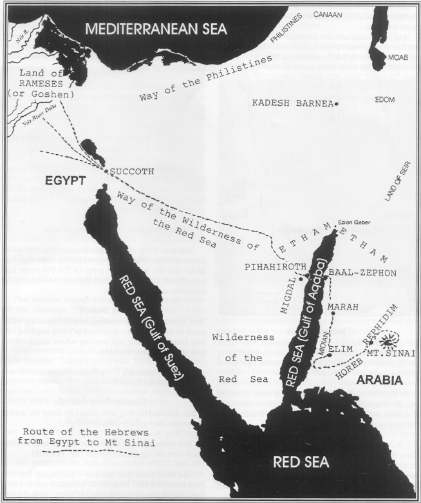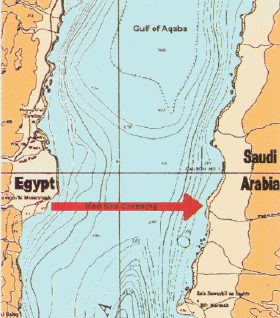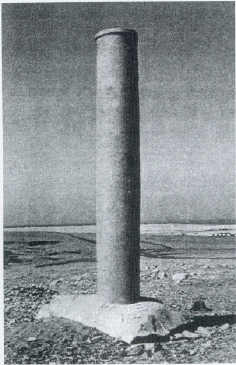IN SEARCH OF PHARAOH’S LOST ARMY
(THE RED SEA CROSSING)
THE desert pushed right down to the water’s edge. And as Sayid, our Egyptian friend, packed the sleeping gear on to the roof rack, Paul watched the sun climb over the sea. If we were not mistaken, there was something quite startling down there on the floor of the Red Sea.
But this whole saga began much, much earlier .. in that ancient land of Egypt.
SPLENDOUR OF EGYPT
Egypt… The very name evokes feelings of romance and mystery. Some 3,500 years ago, in the most glorious era of her history, Egypt was the granary of the world. She was eminent in science, the arts, luxury and magnificence. Egypt was, in a sense, the U.S.A. of that era – the super power of the world.
MOSES’ CHOICE
Egypt – a nation sophisticated though she was – had cast one ethnic group within her borders into slavery.
And the Pharaoh pushed tyranny to the extreme when he decreed that every new-born Hebrew male should be killed.
But by an amazing twist of events one of these infants – Moses – was adopted into the Egyptian Royal Family. He grew up in the palace, educated in all the wisdom of Egypt, being groomed for a position of leadership.
He became a great Statesman and General. Yet his mother had taught him that the thousands of slaves working in the brick-pits were his people, and that his destiny was linked with theirs.
The tirne came for Moses to make his decision. He could choose to become King of what was the world’s greatest empire, or to be numbered among the sweating and grumbling slaves. His sympathies aroused for the Hebrews, he rashly killed an Egyptian and was forced to flee to Midian.
Midian is identified as Northern Saudi Arabia and also East of Palestine (Lexicon Universal Encyclopedia, Vol. 13, p.413). This indicates that Moses travelled across the modern-day Sinai peninsula, around the Gulf of Aqaba, south into Arabia.
When Moses came to Midian in Saudi Arabia, we find him talking to God at Mount Horeb (Ex. 3:1). God told him, “when you bring the people out of Egypt, you shall serve God on this mountain” (Ex. 3:12).
Moses gathered the Israelites at Succoth (Ex. 12:37), an ancient military staging point near the Suez Canal. This place was known to Moses, he being a former Egyptian Military Commander.
There were two ancient trails across the Sinai peninsula for him to take: “the Way of the Philistines” and “the Way of the Wilderness” (Ex. 13:17,18). The quickest way across was the Way of the Philistines because it went north-eastward along the coast of the Mediterranean (a much straighter distance). The other way went southward, tending eastward across the peninsula, then southward again.
From Succoth God sent them by this second route, the Way of the Wilderness (Ex. 13:17,18). At this time they were entering the Sinai peninsula and the Red Sea crossing hasn’t happened yet.
Egypt about the time of the Exodus controlled the whole Sinai peninsula and all of the coastal area up into modern-day Lebanon (Historical Atlas of the Holy Land). As long as Moses, and then later during the Exodus, all of the Israelites, remained in this territory, they were susceptible to the risk of being captured, cornered, and conquered. The Israelites were not a safe distance from the territorial limits of Egypt until they crossed the entire peninsula. It would have been no use to them for God to perform the Red Sea crossing from one part of Egyptian territory into another. This would have been the case if it was the Gulf of Suez or the Suez Canal area that they crossed.
From Succoth the Israelites travelled day and night into the Sinai. After they had travelled a certain distance, “the Lord spake unto Moses, saying, Speak unto the children of Israel, that they TURN… “ (Ex. 14:1,2).
Leaving the highway, the Hebrews turned aside through the Wadi Watir, a wide and wild mountain gorge, a natural roadway from Egypt.
THEY WERE “ENTANGLED IN THE LAND”
The trail led them through an area with mountains all around, which seemed to hem them in. Pharaoh concluded that they had lost their way. “They are entangled in the land, “ he said (Ex. 14:3).
Pharaoh undoubtedly had military observation posts set up throughout the region and was monitoring their progress to within a few hours of accuracy. At any given time he had information to within a few miles as to the Israelites’ location along the road.
“SHUT IN”, THEY CAMPED “BY THE SEA”
With 600,000 men (Ex. 12:37), plus women and children, there must have been at least 2 million people on this march. The Wadi Watir leads in one direction – to a wide expanse of beach on the Gulf of Aqaba.
At this beach, they found themselves “SHUT IN” (Ex. 14:3). Pharaoh said in his heart, “I got you now!” and his army overtook the Hebrews “encamping by the sea, beside Pihahiroth” (Ex. 14:9).
TRAPPED
Once the army entered the area, the Hebrews’ only means of escape would have been to the south. But the mountains to the south extend all the way to the sea – they had no way of escape, or so it seemed.
But here, at this Nuweiba beach, the Lord was getting ready to show the Hebrews how much He really cared for them.
“And Moses said unto the people, Fear not, stand still, and see the salvation of the LORD, which he will show you today, for the Egyptians whom you have seen today, you shall see them no more again forever” (v. 13).
THE SEA OPENS
The cloud that the Hebrews had followed from Egypt now descended between the two camps, enveloping the Egyptian force in darkness, but radiating light to the Hebrew camp.
As night fell, a “STRONG” east wind blew upon the sea, dividing it into two walls. Between these two walls of water, the Hebrews ventured the 13 kilometre distance to the opposite shore.
PHARAOH’S ARMY DROWNED
Then the cloud separating the Hebrews from their pursuers was removed, and the Egyptians saw their quarry escaping. They went down on to the sea bed after them – 600 chariots and 251,000 men (Josephus).
Then, with a heart-chilling roar, the two walls of frozen water (which we may assume had been thawing and thinning since the wind dropped) suddenly collapsed upon them. “The waters covered the chariots “ (Ex. 14:28). The monarch and the nation’s army were in that place of fearful danger by their own choice. They had destroyed themselves!
This disaster to the flower of the Egyptian army and nobility was so overwhelming that Egypt succumbed to looting, disorganisation and anarchy for several years. There was no longer any royal power. Egypt was largely depopulated. And she was defenceless.
It seems evident that those linked events (the waters standing up like 2 walls, plus the TIMING of the waters’ return so as to save the Israelites and destroy all the Egyptians) could have been done ONLY by a direct, miraculous act of God.
THIS alarmed the neighbouring nations.
This was the greatest single disaster that ever befell a nation. In one blow the king, the priests of the Egyptian gods, and the entire elite army of 251,000 men, had been totally destroyed – while the unarmed enemy did not suffer a single casualty.
THE SEARCH
Ron Wyatt had been working and diving along other parts of the Red Sea – and couldn’t find anything. He had been searching and probing where many others had searched over the years. Then he went back to the book of Exodus and found clues previously missed.
CHARIOT PARTS FOUND
When Ron and his two sons found the large flat area at Nuweiba, they got out their diving gear. The Bible account states that the sea had crashed back over the Egyptian chariots (Ex. 14:23-28).
The men went into the sea – and in the first half hour found the FIRST CHARIOT WHEEL. It was in eighty feet (about twenty-five metres) of water. In just a few minutes, Ron found another one. And then, gradually, as his eyes became adjusted to what he was looking at, he found chariot wheels strewn all across the sea bed. Following them, he came upon an area in which parts of CHARIOTS could be made out. These chariot remains were not in perfect condition and required careful examination to see exactly what they were. They were covered in coral, which made it difficult to see them clearly. Could it be that the coral was the agency the Lord had used to preserve them? There were numerous wheels. Some were still on their axles, and some were off.
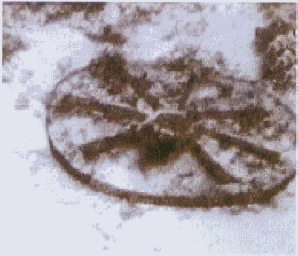 There were chariot cabs without the wheels. So far, this coincided with the biblical account.
There were chariot cabs without the wheels. So far, this coincided with the biblical account.
The ancient report states that the wheels came off the chariots. “The Lord troubled the host of the Egyptians, and took off their chariot wheels” (Ex. 14:24,25).
Have you ever heard it said that you cannot take the Bible literally? That it’s just myth? Well, now we can see how accurate was that DETAIL inserted into the Scripture report. Yes, you CAN TRUST THIS BOOK. It says the Lord TOOK OFF the chariot wheels – and THERE THEY ARE; we’ve got it documented.
A WHEEL TO CAIRO
They found several six-spoked wheels, as well as an eight-spoked wheel. Ron removed the hub of a wheel which had the remains of eight spokes radiating outward from it. He took this to Cairo, to the office of Nassif Mohammed Hassan, the director of Antiquities with whom Ron had been working. Mr Hassan examined it and immediately pronounced it to be of the 18th Egyptian Dynasty. When asked how he knew this so readily, Mr Hassan explained that the eight-spoked wheel was used only during the 18th Dynasty.
There followed a thorough research concerning the Egyptian chariot. According to several sources, it appeared that the discovery of four, six and eight spoked wheels placed the Exodus in the 18th Dynasty. It was ascertained that only during the 18th Dynasty were the four, six and eight spoked wheels used. Monuments can actually be dated by the number of spokes shown in the wheel.
Finally, Ron found a four-spoked gold chariot wheel, which looks almost perfect. The reason this one was so well preserved was that coral does not grow readily on gold. The wood inside the gold “veneer” was deteriorated, which made it very fragile. And for that reason there has been no attempt to retrieve it from the water.
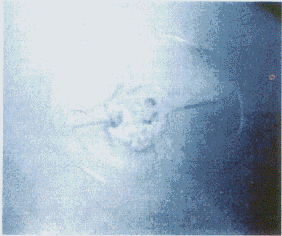 NOWHERE – EXCEPT HERE
NOWHERE – EXCEPT HERE
Of all the archaeological sites I have ever worked, this location is the most mind boggling by far. Why has no trace of Pharaoh’s lost army ever been found? The answer is simple. Until now, every searcher has been looking in the wrong place. And why? It seems that somebody read the Exodus account loosely, rather than scrutinising it for every word, every clue. Writers and map makers followed more or less ad lib, like sheep. And we took it for granted they were right.
The reality is that chariot parts have never been found in the Red Sea anywhere, except now, at this site. The Scripture records that men and horses alike were drowned (Ex. 14:26-28).
As my eyes scanned objects on the sea floor, strange shapes were everywhere. I looked closer at one spot. With a catch at my heart, I realised it was a man’s hand. Strewn along the sea bed were human skulls among the coral, and skeletons partly covered by coral. I shuddered as I held a man’s hipbone, a clavicle and parts of skulls. Yes, even a horse hoof. It was all too real. I have now led several expeditions to the site.
There is no doubt that it happened exactly as the Scriptures say.
SOLOMON’S MONUMENT
A Phoenician style column was found lying on the southern end of the beach. It was partially in the water and the inscriptions had been eroded away, or perhaps purposefully chiselled away. The authorities have since moved this column across the road and set it up in concrete.
The importance of this ancient column was not fully realised until much later. Certainly the column was not of Egyptian style.
Then another column was discovered on the Saudi Arabian side of the sea, almost exactly opposite the first column. This column was identical to the first except that it had the inscriptions intact, on the leeward side. The archaic Hebrew letters were eventually translated. The inscription contained the words:
MIZRAIM (Egypt);
SOLOMON; EDOM; DEATH;
PHARAOH; MOSES; and YAHWEH.
From this, it was deduced that King Solomon had erected these columns in honour of Yahweh (God) and dedicated them to the miracle of the crossing of the sea on dry ground.
FACT – AND FAKE
After the Hebrews crossed the Red Sea, they went to Mount Sinai. If this is so, then the real Mount Sinai would have to be in what is now Saudi Arabia. There is no other option. And to this the New Testament bears witness: “mount Sinai in Arabia” (Gal. 4:25).
How could we have missed that for so long? Today tourists flock to the WRONG COUNTRY to see “Mount Sinai”.
Now, at last, discoveries show that the Exodus story tallies with the facts. The artefacts and skeletal remains are there; they cannot be argued away. But there’s more. On the opposite shore and inland from it are other remains – the precise ones we should expect to find, if the Exodus account were true. Not only that, they are located in the correct geographical order.
ROYAL MUMMY CARGO
Early this century, when some mummies were to be shipped down the Nile to Cairo, the contractors were in a dilemma. There was no cargo classification for “royal mummies,” so you know what they did? The majestic Pharaohs had to travel under the designation, “Dried fish”!
Moses, motivated by the grand mission for which his God had called him, refused the throne, the wealth and the splendour of the world’s most pompous nation. Today his name is honoured.
With acknowledgement to Archaeological Discoveries

